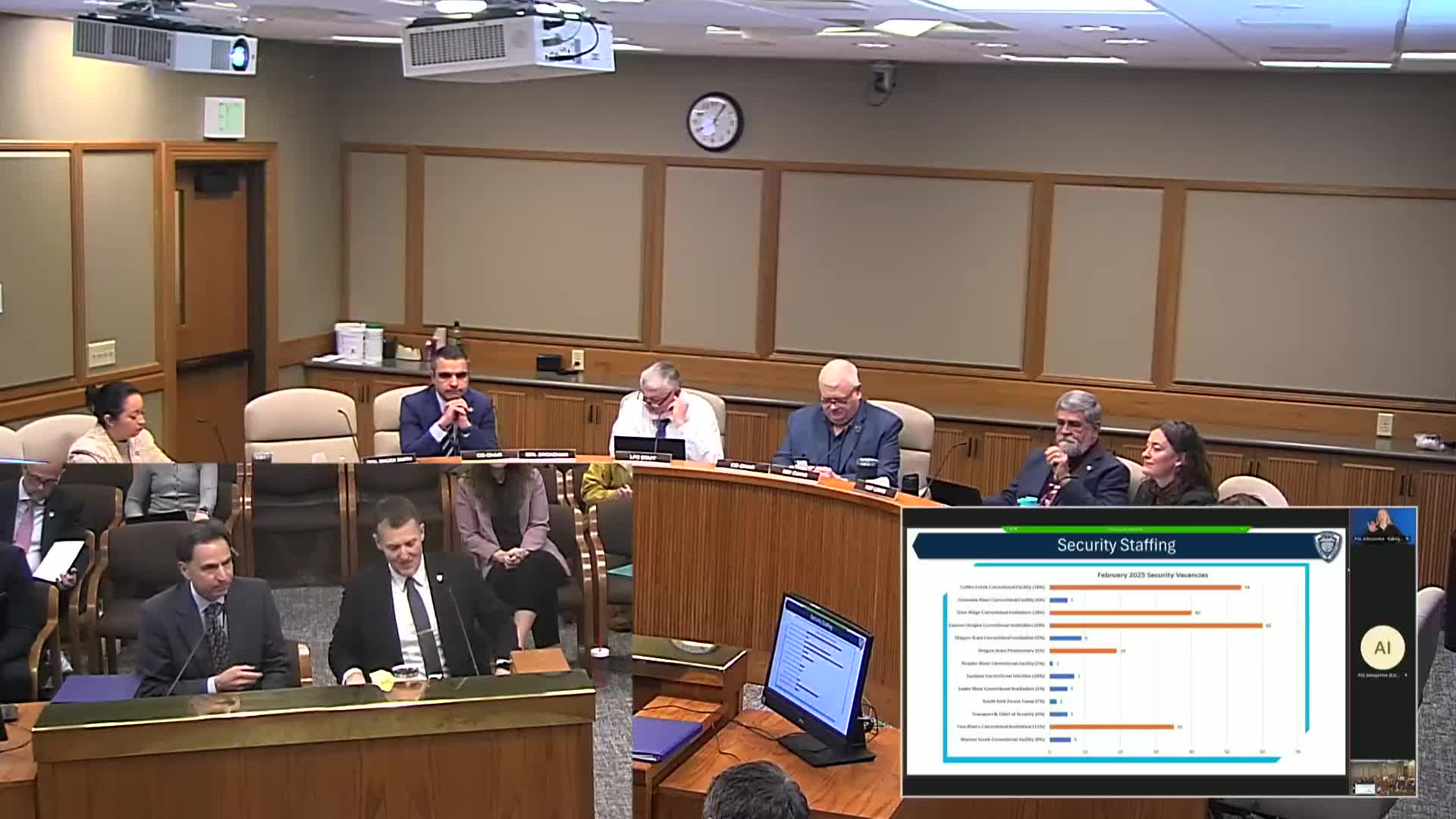Oregon DOC tells budget panel it has 248 security vacancies, pilots new trainee roles
March 11, 2025 | Public Safety, Ways and Means, Joint, Committees, Legislative, Oregon
This article was created by AI summarizing key points discussed. AI makes mistakes, so for full details and context, please refer to the video of the full meeting. Please report any errors so we can fix them. Report an error »

PORTLAND, Ore. — The Oregon Department of Corrections told the Public Safety Subcommittee on March 11 that it currently has 248 statewide vacancies in its security series, including about 200 correctional officer positions, and that those shortages are forcing changes to daily operations and increasing overtime.
"Currently, we have 248 statewide vacancies in the security series with 200 of those being correction officer positions," Josh Heiberger, assistant director of operations for the Oregon Department of Corrections, said during the hearing on House Bill 5004, the department's budget bill.
Heiberger and Director Mike Reese said five facilities account for roughly 84% of the department's security vacancies. The short staffing has led institutions to close nonessential posts and reduce recreation and program time for adults in custody, the department said.
Why it matters: staffing gaps in a 24‑hour corrections operation change how facilities run day to day and increase safety risks and overtime costs. Lawmakers pressed DOC staff on recruitment, retention and whether recent efforts are producing measurable improvements.
DOC outlined several near‑term steps the agency has taken: hiring a human resources assistant at Coffee Creek Correctional Facility, adding two HR positions to support hiring at the highest‑vacancy institutions, and creating a temporary ‘‘correctional specialist trainee’’ classification launched in December 2024. Heiberger said 22 people had been hired into the trainee classification, with 17 now filling positions or moving toward permanent correctional officer status and four having left the program so far.
"Although it's still early in the process, we are seeing positive gains," Heiberger said when presenting three‑month before/after hiring data comparing September–November to December–February.
Committee members asked whether regional factors — such as housing availability and local labor markets — explain differences in vacancy rates between Eastern Oregon institutions and facilities closer to the Portland metro area. Heiberger cited housing availability, cost of living, and competition from other employers as contributing factors.
The department also said it is adding recruitment capacity and experimenting with training alignment with DPSST so that certifications could be portable between county and state work, a step lawmakers signaled they support.
Department leaders emphasized the human impact of vacancies on staff and adults in custody, and the need for continued investment in recruitment and retention to avoid recurring overtime and service reductions.
Looking ahead: DOC told the committee it will continue to track results from the trainee program and additional HR positions and report back with updated vacancy and hiring metrics.
"Currently, we have 248 statewide vacancies in the security series with 200 of those being correction officer positions," Josh Heiberger, assistant director of operations for the Oregon Department of Corrections, said during the hearing on House Bill 5004, the department's budget bill.
Heiberger and Director Mike Reese said five facilities account for roughly 84% of the department's security vacancies. The short staffing has led institutions to close nonessential posts and reduce recreation and program time for adults in custody, the department said.
Why it matters: staffing gaps in a 24‑hour corrections operation change how facilities run day to day and increase safety risks and overtime costs. Lawmakers pressed DOC staff on recruitment, retention and whether recent efforts are producing measurable improvements.
DOC outlined several near‑term steps the agency has taken: hiring a human resources assistant at Coffee Creek Correctional Facility, adding two HR positions to support hiring at the highest‑vacancy institutions, and creating a temporary ‘‘correctional specialist trainee’’ classification launched in December 2024. Heiberger said 22 people had been hired into the trainee classification, with 17 now filling positions or moving toward permanent correctional officer status and four having left the program so far.
"Although it's still early in the process, we are seeing positive gains," Heiberger said when presenting three‑month before/after hiring data comparing September–November to December–February.
Committee members asked whether regional factors — such as housing availability and local labor markets — explain differences in vacancy rates between Eastern Oregon institutions and facilities closer to the Portland metro area. Heiberger cited housing availability, cost of living, and competition from other employers as contributing factors.
The department also said it is adding recruitment capacity and experimenting with training alignment with DPSST so that certifications could be portable between county and state work, a step lawmakers signaled they support.
Department leaders emphasized the human impact of vacancies on staff and adults in custody, and the need for continued investment in recruitment and retention to avoid recurring overtime and service reductions.
Looking ahead: DOC told the committee it will continue to track results from the trainee program and additional HR positions and report back with updated vacancy and hiring metrics.
View full meeting
This article is based on a recent meeting—watch the full video and explore the complete transcript for deeper insights into the discussion.
View full meeting
